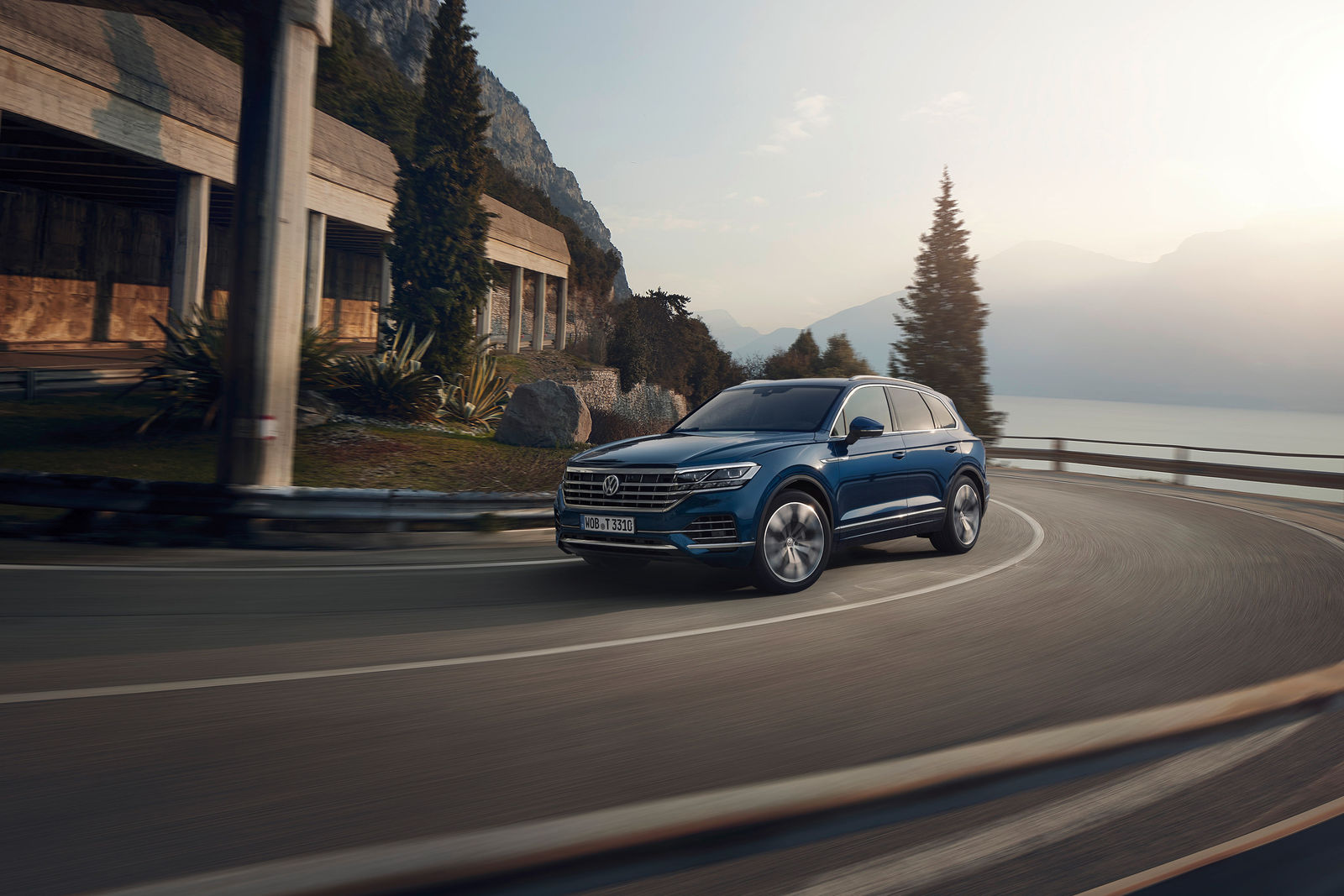Light aluminium for the running gear. The running gear of the new Touareg was was largely newly developed to further perfect the comfort and dynamic properties. Volkswagen is once again offering a 4-Corner air suspension with electronic damping control for the Touareg as an option. It has been significantly enhanced. A complete new development is the active roll compensation with electromechanical adjustable anti-roll bars. An all-wheel steering system that makes the large SUV agile and manoeuvrable similar to a compact SUV has also been newly developed. Generally five-link suspensions with a light aluminium/steel design are used. An overview of the individual elements shows where aluminium is used for the axles.
The front axle consists of the following elements
- Shock absorber (dual tube shock absorber)
- Steel springs (with linear characteristics)
- Suspension struts (aluminium-cast construction)
- Ball joints and transverse link/wheel bearing housing
- Connecting rod, top level (aluminium-forged construction)
- Wheel bearing housing (aluminium-forged construction)
- Coupling rods (aluminium housing with rubber-metal bearings)
- Guide link (aluminium-forged construction)
- Cross brace in steel design (with bolted subframe)
- Track control link (aluminium-forged construction)
- Anti-roll bar
The rear axle consists of the following elements
- Top and bottom transverse link (steel construction; designed as aluminium-forged construction in the case of air suspension running gear and all-wheel steering system)
- Shock absorber (dual tube shock absorber)
- Steel springs (with linear characteristics)
- Track guide (steel construction)
- Coupling rods (aluminium-extrusions)
- Subframe (steel construction)
- Spring link (aluminium-extrusions)
- Aerodynamic trim (attached to spring link)
- Hub carrier (aluminium-cast frame)
- Anti-roll bar
Active roll compensation. The adaptive roll compensation is a new development as outlined. From now on it is referred to as “electromechanical active roll stabilisation” (”eAWS”) due to its structural design. The two most important components of the eAWS are the anti-roll bars at the front and rear axle. Conventional running gears are equipped with a steel anti-roll bar at the front and rear that stretches from one axle side to the other. The two sides of the anti-roll bar twist against each other on curves (or when driving over larger bumps with only one side of the vehicle). The kinematics cause the roll angle of the car to be reduced on curves. This works even better with the active roll compensation “eAWS”:
Electromechanical anti-roll bars. To extend the limits of driving physics, the Touareg equipped with eAWS has electromechanical anti-roll bars at the front and rear axle. A central control unit coordinates its use. The two sides of the relevant anti-roll bar are connected to each other via a control motor in this case. Depending on the driving situation, the two halves of the anti-roll bar are either twisted against each other (stiffened) or decoupled using an electric motor. The necessary high voltage of 48 volt to activate the powerful electric motors is briefly established using so-called “Super Cabs” (capacity accumulators). The side inclination of the Touareg is significantly reduced on curves due to the active anti-roll bars. The directional stability is also significantly increased on roads where one side is uneven. On terrain, the interlacing of the axles and therefore the traction can be improved due to the electromechanical decoupling of the anti-roll bars.
All-wheel steering system. Another innovation on board the Volkswagen is the optional all-wheel steering system. This is because all four wheels are driven at the same time depending on the driving situation. The all-wheel steering system helps the Touareg to be the most agile large SUV. The all-wheel steering system essentially affects two driving states: Speeds below 37 km/h and speeds over 37 km/h. Up to 37 km/h, the rear wheels drive automatically at an opposing angle to the front wheels. As a result, agility and manoeuvrability is improved. Particularly when manoeuvring the turning circle, reduced by one metre from 12.19 m to 11.19 m with all-wheel steering, is noticeable. If the speed increases to more than 37 km/h, the rear wheels automatically drive in the same direction when steering in the same way as the front wheels. As a result, the driving behaviour is significantly smoother as the all-wheel steering stabilises the lane change – when overtaking quickly. The same applies for sudden evasive manoeuvres.
Enhanced 4-Corner air suspension. The new generation 4-Corner air suspension not only perfects the level of comfort, but also the aerodynamics and trips on rough terrain. The new open air suspension system operates quickly and silently and is insensitive to temperature and outside pressure fluctuations (as in the mountains). The air suspension is at the “Normal level” or “Comfort level” as standard. In addition a “Terrain level” increased by 25 mm and a “Special terrain level” by 70 mm are also available. At speeds from 120 km/h, the running gear is automatically lowered by 15 to 25 mm using the air suspension (deep level) to reduce the air resistance and adjust the driving behaviour. Last but not least, there is a “Load level” (minus 40 mm) available that simplifies loading and unloading the luggage compartment.
Air suspension optimises offroad parameters. The offroad parameters change depending on the suspension. The maximum climbing capability (60 percent) and transverse gradient (35 degrees) are identical with steel and air suspension. The front and rear ramp angle increases with air suspension from 25 to 31 degrees. The breakover angle also increases from 18.5 to 25 degrees. As the ground clearance can be increased with air suspension, the maximum wading depth also increases (from 490 to 570 mm). The manually adjustable level of the air suspension is activated using rotary pushbutton switches in the centre console.
